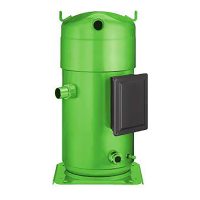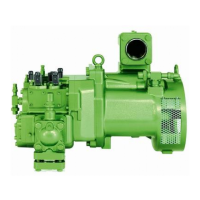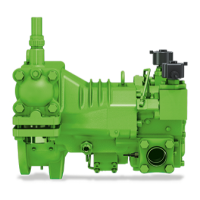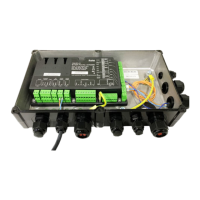KB-120-832
6.3.1 Checking the operating data
After successful commissioning and charging of refri-
gerant, check the operating data and create a data pro-
tocol:
• Evaporation temperatures and high pressure – see
application limits KP-120 and KP-122.
• Suction gas temperature, discharge gas temperature
and oil temperature, see chapter Operating temper-
atures and lubrication conditions, page 32.
• Cycling rate:
– max. 6 starts per hour
– min. time for a start / stop cycle = 10min
• Current values of all phases.
• Voltage.
Create a data protocol.
7 Operation
7.1 Operating temperatures and lubrication
conditions
NOTICE
Operation at low pressure ratios and low suction
gas superheat results in low discharge gas and
oil temperatures.
Danger of insufficient lubrication due to the high
solubility of CO
2
in oil.
Avoid operation at low pressure ratios and low
suction gas superheat.
With respect to the lubrication conditions, the following
requirements must be complied with:
• Always use an oil heater, particularly during stop
phases.
• Minimum suction gas superheat 20 K – provide an
heat exchanger if necessary.
• Oil temperature 30°C (20°C = absolute minimum
value!).
• Minimum discharge gas temperature = condensing
temperature (t
c
) + 40K.
For continuous operation, the oil temperature must
not fall below 30°C and pressure gas temperature
not below 50°C!
• Maximum discharge gas temperature: measured at
the discharge gas pipeline (10cm distance from the
discharge gas connection of the compressor):
– 2MME-07K .. 6PME-40K: 140°C
– 2NSL-05K .. 4NSL-30K: 140°C
7.2 Regular tests
Check the system at regular intervals according to na-
tional regulations. Check the following points:
• Operating data, see chapter Compressor start, page
31.
• Oil supply, see chapter Compressor start, page 31.
• Protection devices and all components for com-
pressor monitoring (check valves, discharge gas
temperature limiters, differential oil pressure
switches, pressure limiters, etc.).
• Tight seat of electrical cable connections and
screwed joints.
• Screw tightening torques.
• Check refrigerant charge.
• Tightness test.
• Update data protocol.
Moreover observe the following points:
• Replace the pressure relief valves of the com-
pressors after deflating because the opening pres-
sure may be reduced after this procedure.
• Check the sight glass and its joint at regular intervals
and replace them if necessary.
• Check the opto-electronic oil monitoring (OLC-K1) at
regular intervals and replace it, if necessary.
• Check the cylinder banks. Dismount the cylinder
heads, check the valve plate and replace it, if neces-
sary.
NOTICE
Risk of damage to the compressor.
Tighten screws and nuts only to the prescribed
tightening torque and, if possible, crosswise in
at least 2 steps.
Perform a tightness test before commissioning!

